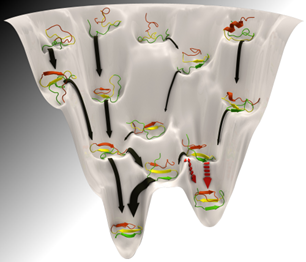Simulation
Molecular Dynamics and the Sampling Problem
All life processes are based on the fact that biomolecules can exist in and switch between different conformations. A conformation is a set of similar structures associated to a specific biological function. Conformational dynamics includes internal biomolecular dynamics (e.g. protein / RNA folding or native conformational changes), binding or association of ligands or other biomolecules, and structural rearrangements during catalysis. What every molecular biologist dreams of is to have a universal, efficient and reliable tool to explore the conformations and the conformational dynamics of a given biomolecule or complex of biomolecules. Not only would this yield the key to fundamental understanding of how cells work, it would also provide us with the ability to design efficient drugs, construct biomaterials with desired functions, and achieve a multitude of technological goals.
Experiments are expensive and at the same time very limited in their ability to trace molecular structure and dynamics simultaneously. From a theoretical perspective, atomistic molecular dynamics (MD) models are our best bet as they describe the molecular properties relevant to molecular function. Also they are becoming mature enough to be quantitatively reliable. Unfortunately to date, the usefulness of MD is limited by the famous sampling problem: The direct simulation of a single millisecond process in a protein would require decades if not centuries on a modern supercomputer. We believe that MD can be sped up by many orders of magnitude without significant accuracy loss. We are therefore developing and applying innovative mathematical and biophysical methods to solve or alleviate the sampling problem in biomolecular simulation, and thus to turn MD into an universal and efficient tool for exploring conformational dynamics. Together with other groups, we have worked on the conformation dynamics theory and pioneered Markov models as a method of modeling molecular dynamics and driving molecular simulations.
For more information see markovmodel.org
Collaborators
Gianni de Fabritiis | PRB Barcelona | High-performance computing, Markov modeling
John D. Chodera | MSKCC, NYC | Various theoretical and methodological topics
Cecilia Clementi | Rice University | Diffusion maps and multiscale modeling
Alessandro Laio | SISSA, Trieste | TRAM and Metadynamics
Vijay S Pande | Stanford | Method and software development
Christof Schütte | FU Berlin | Markov modeling and conformation dynamics
Eric Vanden-Eijnden | Courant Inst. NYC | Markov modeling & transition path theory

